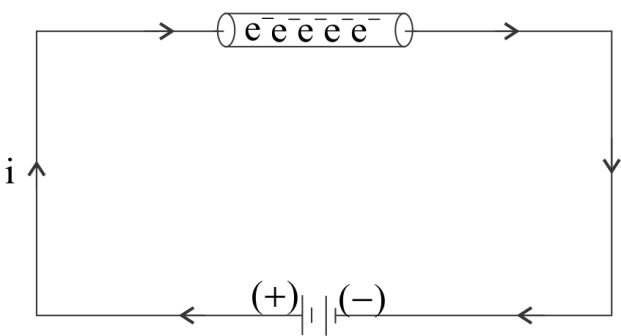
Current in a circuit flows:
(A) In direction from high potential to low potential
(B) In direction from low potential to high potential
(C) In direction of flows of electrons
(D) In any direction.
Answer
216.6k+ views
Hint:
Electrons always flow in opposite directions.
OR
The direction of an electric current is by convention the direction in which a positive charge would move.
Complete Step by Step Answer
Electric current flows from higher electric potential to lower electric potential.

If we put metal in an electrical circuit. As we know that current flows from positive terminal to negative terminal.
Then a positive terminal flows in the current direction. If electrons are present in metal then they flow opposite to applied current which means current flows in the direction of electric field.
Positive terminal is considered as high potential and negative charge is considered as low potential. The direction of motion of positive charge is always high potential to low potential but direction of motion of negative charge is always from low potential to high potential.
Which could be represented as
$V = - \phi \vec E.dr$
So we can say that current flows the same as direction of field and high potential to low potential.
Therefore we conclude that direction of current is always opposite to the direction of current that is high potential to low potential.
Hence the correct option is A.
Note:
For the current to flow, it required a circuit which is a closed loop of a conducting material. The circuit consists of wires which are connected end to end and the electrons flow in the same direction.
Electrons always flow in opposite directions.
OR
The direction of an electric current is by convention the direction in which a positive charge would move.
Complete Step by Step Answer
Electric current flows from higher electric potential to lower electric potential.

If we put metal in an electrical circuit. As we know that current flows from positive terminal to negative terminal.
Then a positive terminal flows in the current direction. If electrons are present in metal then they flow opposite to applied current which means current flows in the direction of electric field.
Positive terminal is considered as high potential and negative charge is considered as low potential. The direction of motion of positive charge is always high potential to low potential but direction of motion of negative charge is always from low potential to high potential.
Which could be represented as
$V = - \phi \vec E.dr$
So we can say that current flows the same as direction of field and high potential to low potential.
Therefore we conclude that direction of current is always opposite to the direction of current that is high potential to low potential.
Hence the correct option is A.
Note:
For the current to flow, it required a circuit which is a closed loop of a conducting material. The circuit consists of wires which are connected end to end and the electrons flow in the same direction.
Recently Updated Pages
Wheatstone Bridge Explained: Working, Formula & Uses

Young’s Double Slit Experiment Derivation Explained

JEE Atomic Structure and Chemical Bonding important Concepts and Tips

JEE Amino Acids and Peptides Important Concepts and Tips for Exam Preparation

Electricity and Magnetism Explained: Key Concepts & Applications

Chemical Properties of Hydrogen - Important Concepts for JEE Exam Preparation

Trending doubts
JEE Main 2026: Application Form Open, Exam Dates, Syllabus, Eligibility & Question Papers

Derivation of Equation of Trajectory Explained for Students

Hybridisation in Chemistry – Concept, Types & Applications

Understanding the Angle of Deviation in a Prism

Understanding Collisions: Types and Examples for Students

How to Convert a Galvanometer into an Ammeter or Voltmeter

Other Pages
JEE Advanced Marks vs Ranks 2025: Understanding Category-wise Qualifying Marks and Previous Year Cut-offs

Understanding Atomic Structure for Beginners

Ideal and Non-Ideal Solutions Explained for Class 12 Chemistry

Degree of Dissociation: Meaning, Formula, Calculation & Uses

Understanding Electromagnetic Waves and Their Importance

Understanding the Electric Field of a Uniformly Charged Ring




